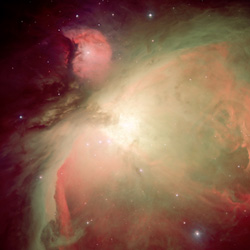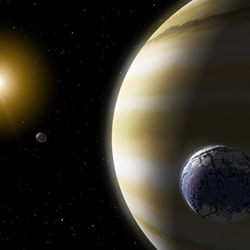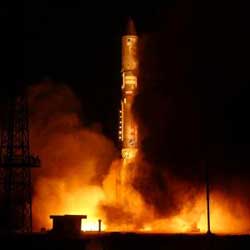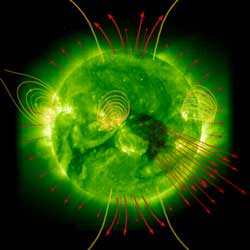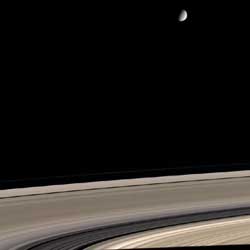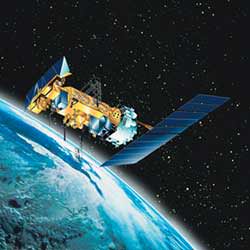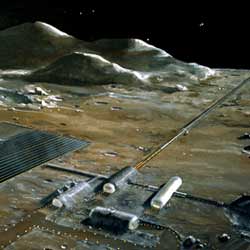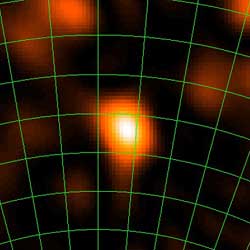
Image credit: Steve Mandel. Click to enlarge.
Monday, May 23 – Tonight at 20:18 UT the Moon is officially “full”. Also known as “Flower Moon” or “Corn Planting Moon”, we often overlook the simple beauty of practicing astronomy without a telescope. This evening as the Sun sets and the Moon rises opposite of it, take advantage of some quiet time and really stop to look at the eastern horizon. If you are lucky enough to have clear skies, you will see the Earth’s shadow rising – like a dark, sometimes blue band – that stretches around 180 degrees of horizon. Look just above it for a Rayleigh scattering effect known as the “Belt of Venus”. This beautiful pinkish glow is caused by the backscattering of sunlight and is often referred to as the anti-twilight arch. As the Sun continues to set, this boundary between our shadow and the arch rises higher in the sky and gently blends with the coming night. What you are seeing is the shadow of the Earth’s translucent atmosphere, casting a shadow back upon itself. This happens every night! Pretty cool, huh?
Tuesday, May 24 – This morning will be an early wake up call for Canada, the United States and Mexico as the opportunity arises for most viewers across the continent to see bright Antares occulted by the Moon! Easily viewed without special equipment, an occultation of this type is quite wonderful to watch. I urge you to visit the IOTA webpage to get complete information for your area. Wishing you clear skies…
With just a short time before the Moon rises tonight, why not try your hand at locating globular cluster M68 with binoculars or small scopes. Start by identifying the lopsided rectangle of Corvus to the south and the lower left-hand star, Beta. About two finger widths south of Beta, you will see a 5th magnitude star – aim there. This is ADS 8612 (a telescopic double) and you’ll find M68 easily about 45′ to the northeast.
Discovered 1780 by Charles Messier, this near 8th magnitude globular cluster lies at a distance of about 33,000 light years and is somewhat difficult for Northern observers because of its southern position. It will be seen as a round, faint patch in binoculars but the brightest stars of M68 can resolved by telescopes starting at 4-inch aperture. Larger scopes will enjoy its bright core and resolved stars fading out to the edges.
Wednesday, May 25 – With plenty of time to spare before “moonrise” tonight, let’s go hunting a spectacular globular cluster well suited to all instruments – M5. To find M5 easily, head southeast of Arcturus and north of Beta Librae to identify 5 Serpentis. At low power, or in binoculars you will see this handsome globular in the same field to the northwest.
First discovered by Gottfried Kirch and his wife in 1702, while observing a comet, Charles Messier found it on his own on May 23, 1764. Although Messier said it was a round nebula that “doesn’t contain any stars”, even smaller scopes can resolve out the curved patterns of stars that extend from M5’s bright nucleus. Binoculars will reveal it with ease and for a real challenge, large telescopes can find about 11.8 magnitude globular Palomar 5 about 40′ south of the star 4 Serpentis. Under very dark, clear skies, M5 can just be glimpsed unaided, but telescopes will enjoy the slight ellipticity of this 13 billion year old ball of stars.
Thursday, May 26 – Have you checked your equinox marker lately? If not, then have a look when the Sun reaches the zenith today. For the northern hemisphere, you’ll find the shadow is almost 75% shorter!
Australia and New Zealand – it’s your turn as the Moon occults bright Tau Saggitarius for you on this universal date. Be sure to check IOTA for precise times in your location.
Tonight asteroid Pallas with be around one half degree north of star 5 Coma Berenices. At magnitude 8, it will be far brighter than any star nearby. Need a locator chart? Check with Heaven’s Above under the minor planets section. Or, if you’d rather take things a bit more Ceres-ly, try spotting 7.6 magnitude Ceres just about a degree west of Delta Librae with a similar magnitude apparent double star.
Friday, May 27 – Since the Moon will rise considerably later tonight, let’s try a series of challenges designed to intrigue all observers.
For visual observers, your goal lay mid-way between Saturn and bright Regulus. Allow your eyes plenty of time to dark adapt and look for a hazy patch of barely there stars. Congratulations! You’ve just spotted the M44 and seen the light – the light that left the cluster in the year 1480!
For binoculars, your challenge is to locate Theta Leonis (the southwestern-most star in the “hips” of Leo) and look directly between it and Iota to its south and spot dim star 73. Aim your binoculars there and discover the joy of galaxy-hunting as you view the M65 and M66 galaxies!
For smaller and mid-sized telescopes, make a fist at Spica – this is 10 degrees. No matter where you are, you’ll easily find the grand M104 “Sombrero” galaxy just 11 degrees due west of this bright blue star. (If you still have trouble finding the M104, don’t worry. Try this trick! Look for the upper left hand star in the rectangle of Corvus – Delta. Between Spica and Delta is a diamond-shaped pattern of 5th magnitude stars. Aim your scope or binoculars just above the one furthest south.)
For the large telescope and seasoned observer, your challenge for this evening will be five and a half degrees south of Beta Virginis and one half degree west. Classified as Arp 248, and more commonly known as “Wild’s Triplet”, these three very small interacting galaxies are a real treat! Best with around a 9mm eyepiece, use wide aversion and try to keep the star just north of the trio at the edge of the field to cut glare.
Best of luck!
Saturday, May 28 – On this day in 1959, the first primates made it to space. Abel (a rhesus monkey) and Baker (a squirrel monkey) lifted off in the nose cone of an Army Jupiter missile and were carried to sub-orbital flight. Recovered unharmed, Abel died just three days later from anesthesia during an electrode removal, but Baker lived on to a ripe old age of 27.
For viewers in Asia, tonight will present a rare occurrence of the position of Jupiter’s moons between 19:05 and 19:14 UT. At that time, Io will be transitting Jupiter, Ganymede will be eclipsed by its shadow and Europa will be occulted by Callisto.
If you haven’t checked on Comet Machholz lately, try looking around eight degrees southeast of Gamma Ursae Majoris tonight. Having quietly faded to around magnitude 9, you still might be able to spot a slight tail. For a very accurate locator chart, use Heaven’s Above and click on the appropriate link.
Sunday, May 29 – Today in 1919, a total eclipse of the Sun occurred and stellar measurements taken along the limb agreed with predictions based on Einstein’s General Relativity theory – a first! Although we call it gravity, the spacetime curve deflects the light of stars near the limb, causing their apparent position to differ slightly. Unlike today’s astronomy, at that time you could only observe stars near the Sun’s limb (less than an arc second) during an eclipse. It’s interesting to note that even Newton had his own theories on light and gravitation which predicted deflection!
If you haven’t looked for Venus lately, check out the lower western skyline tonight. Now clearing about 13 degrees above the horizon, it will “hang out” for about 90 minutes after sunset allowing you an opportunity to catch its almost full form.
So where’s comet 9/P Tempel 1 tonight? Easy enough! Look about a degree north of Delta Virginis. Although there are several small galaxies in the neighborhood, Tempel 1 is approaching magnitude 9 and will be far brighter than any galaxy. At my last observation with a large scope, Tempel 1 has developed a stellar nucleus and a short tail. Enjoy!
Suffering through the temperamental weather changes? Don’t despair. Remember that most of these observing tips can be practiced almost any night. Until next week? I’m looking forward to dark skies again and finding more challenges for you! May all your journeys be at Light Speed… ~Tammy Plotner

